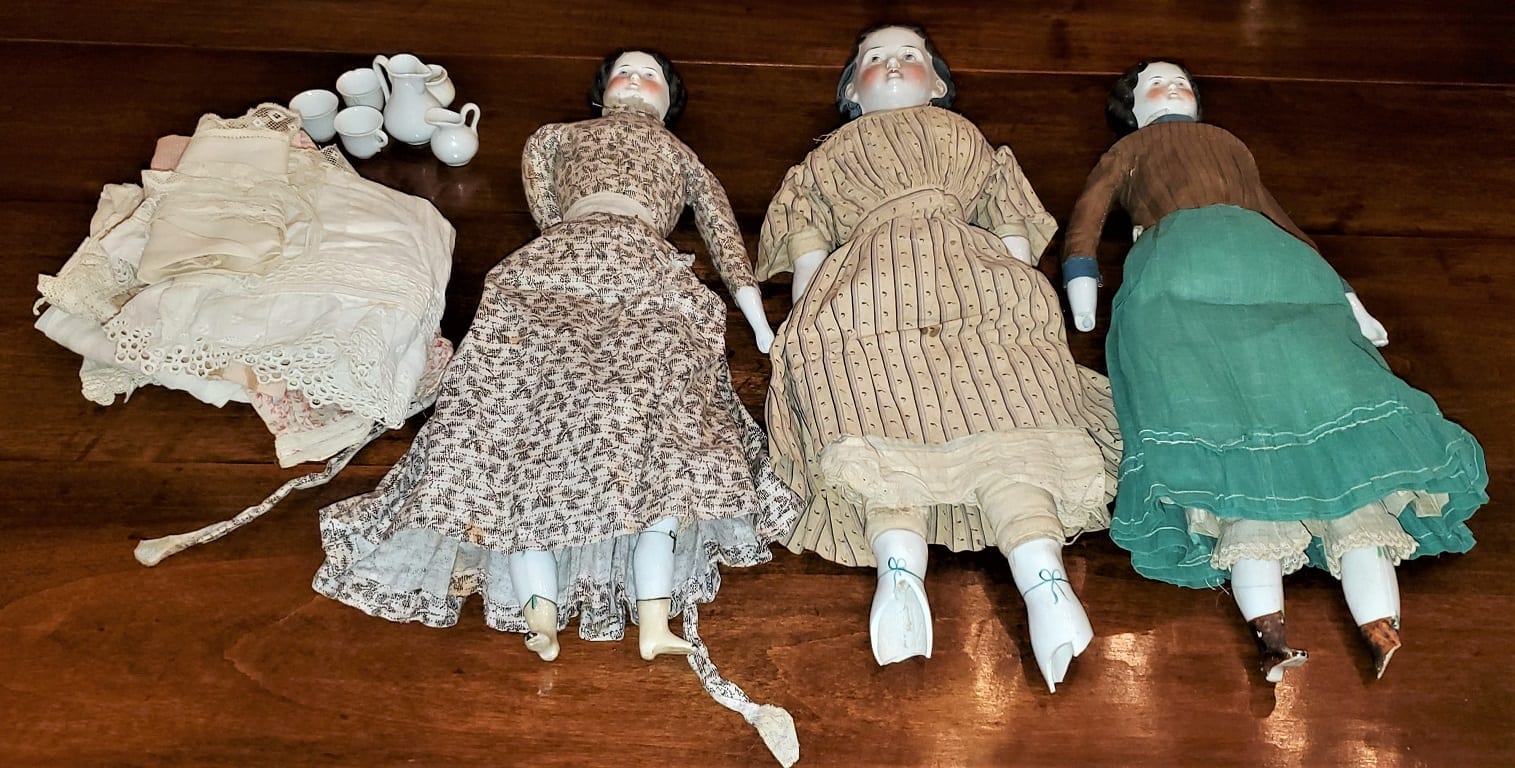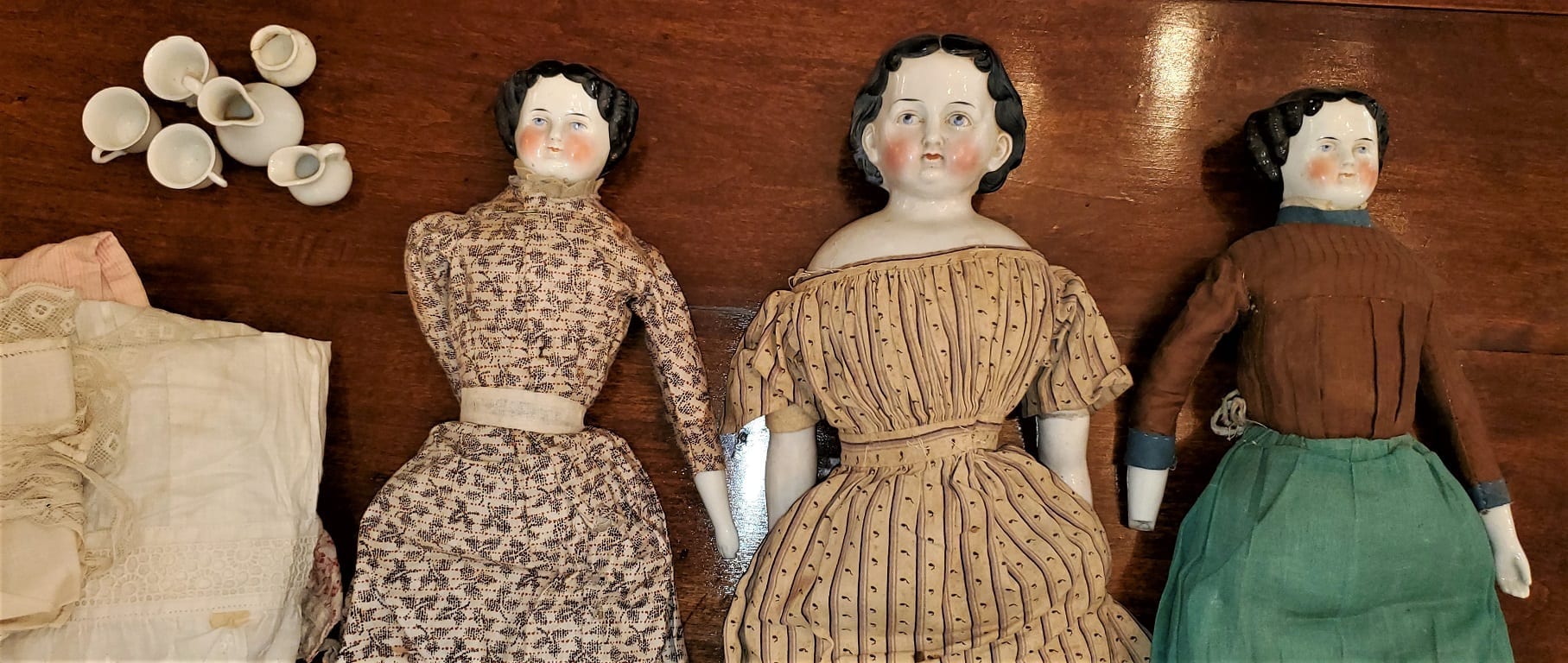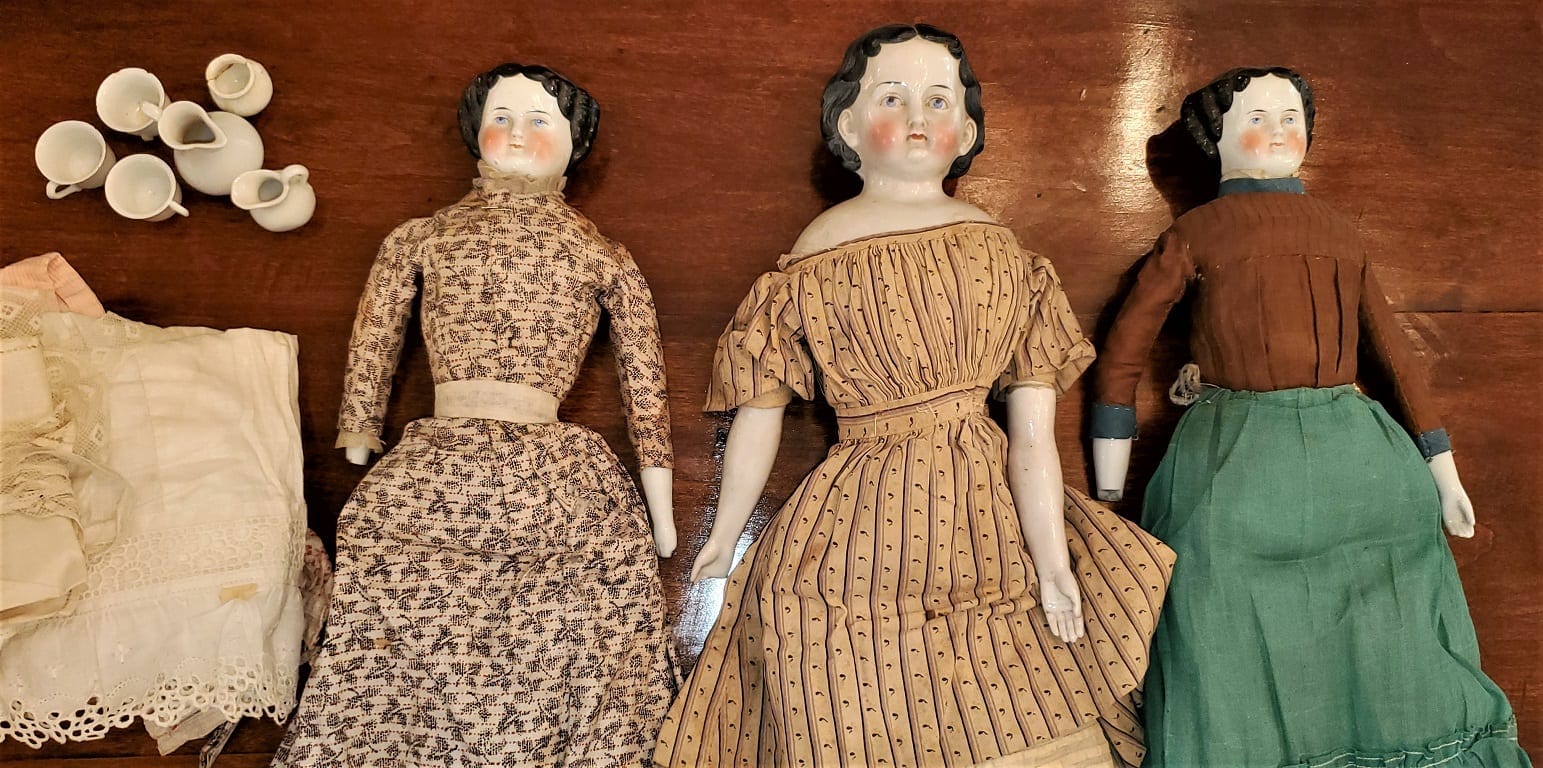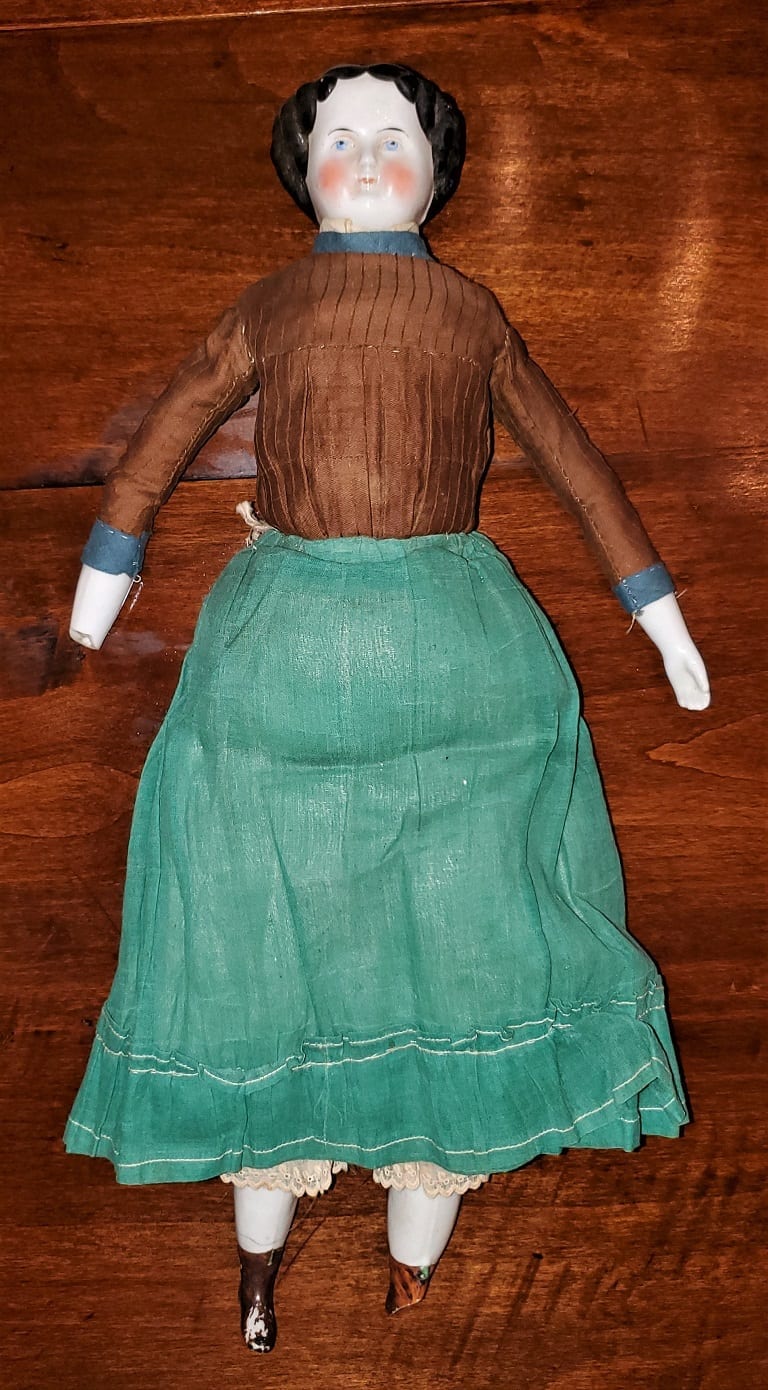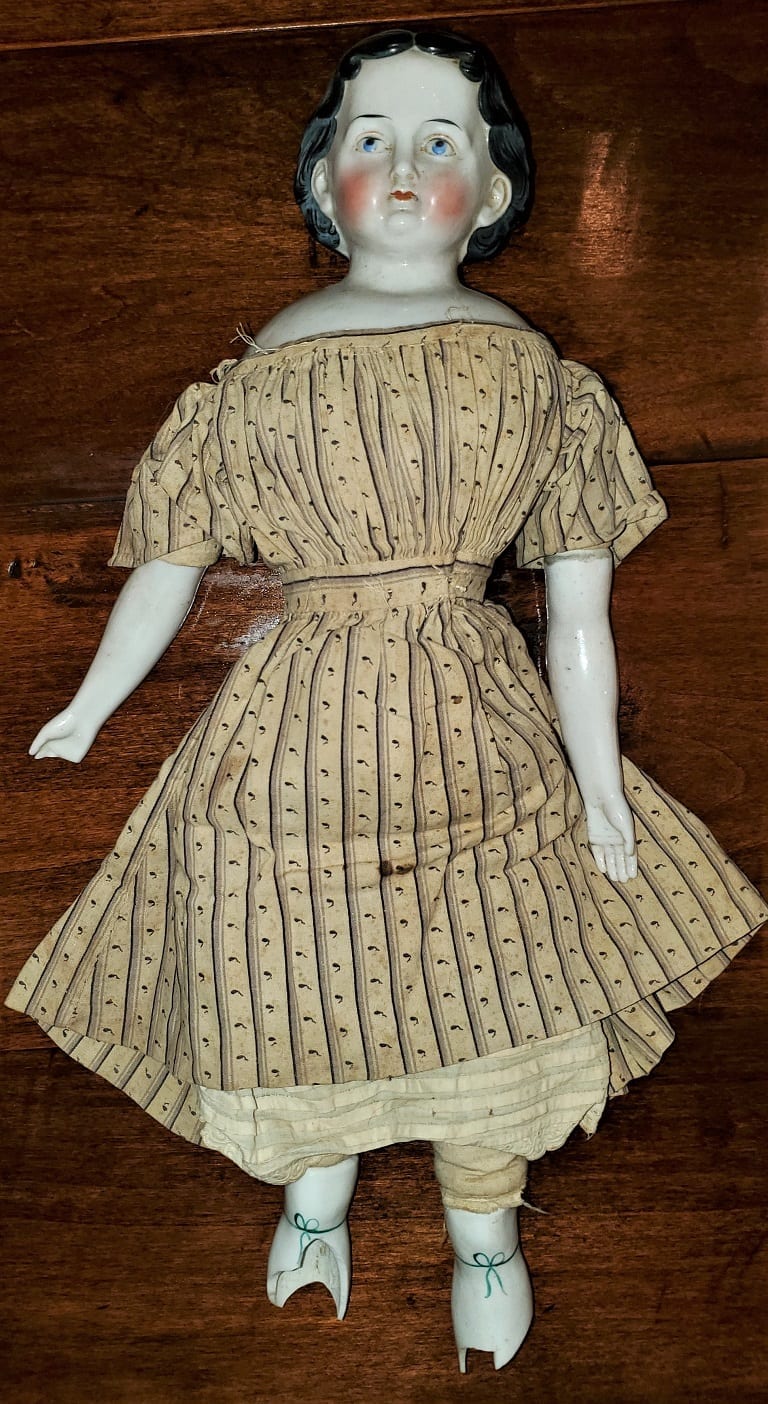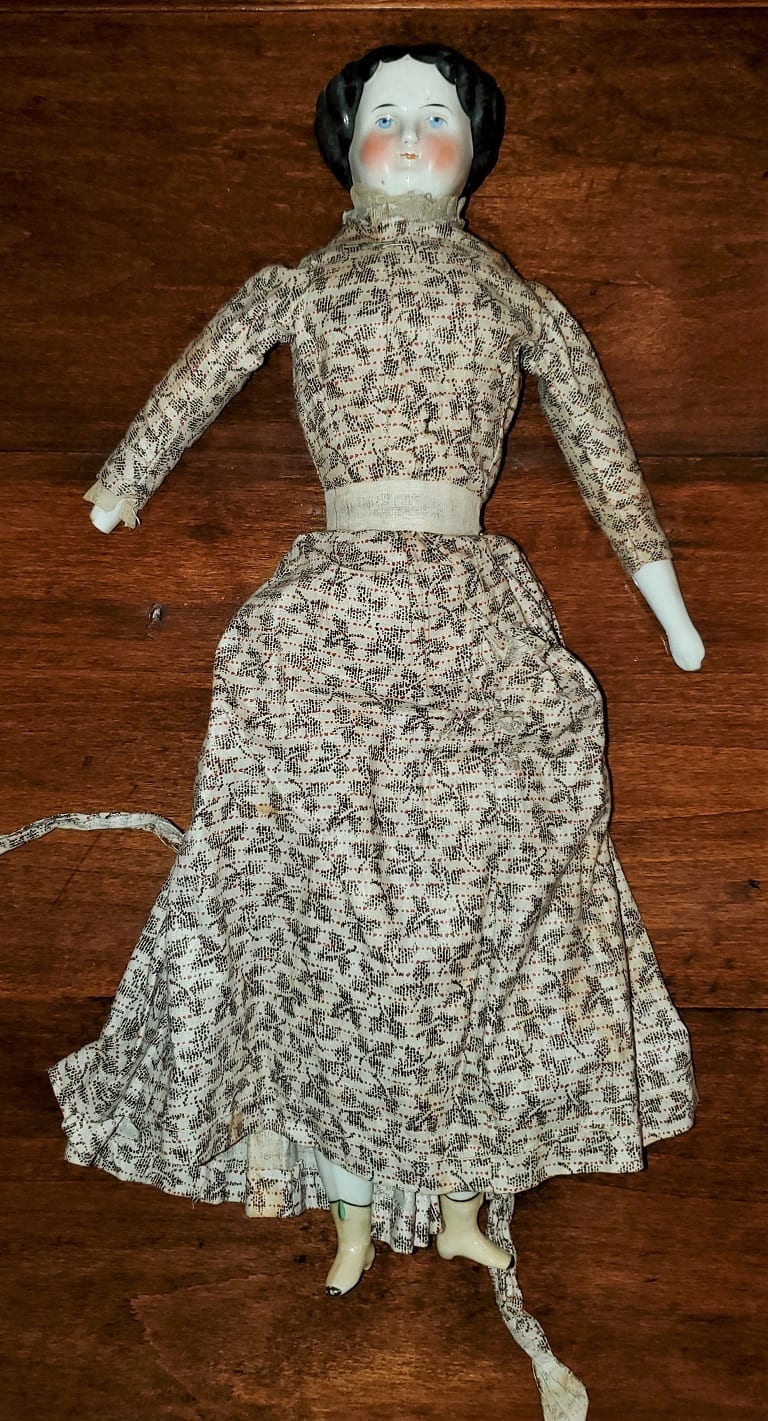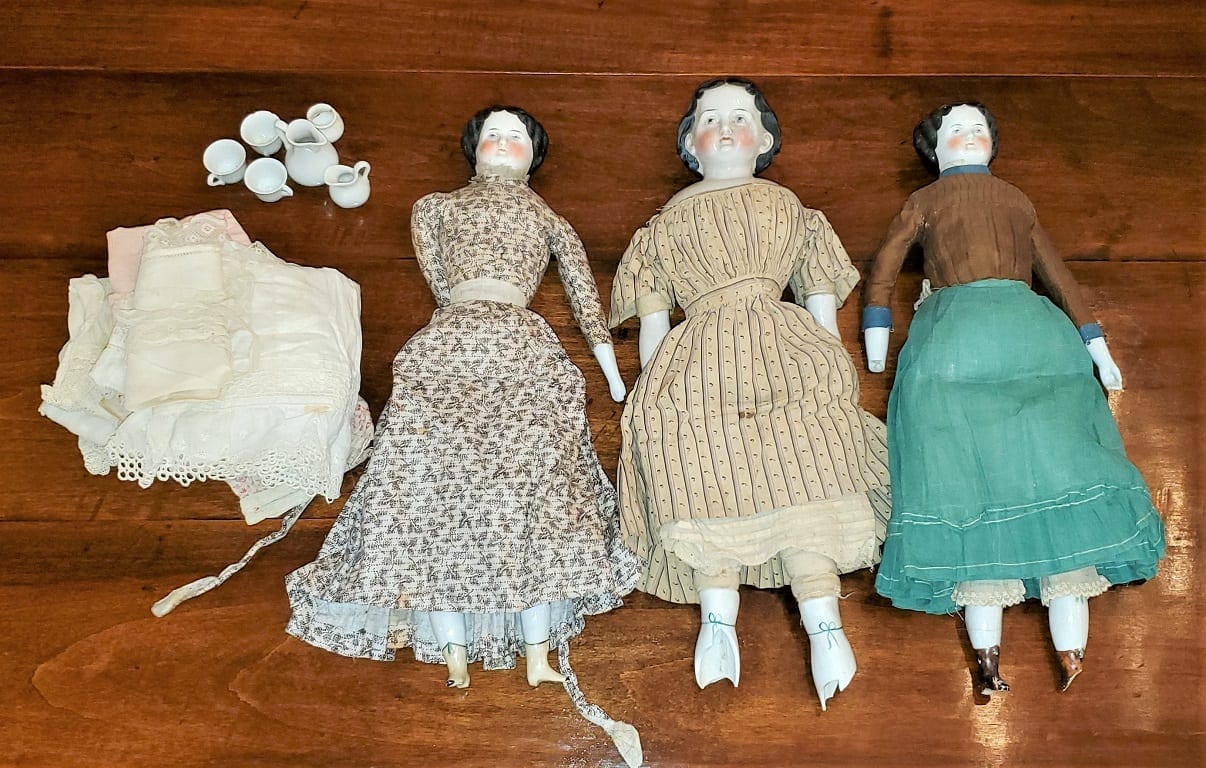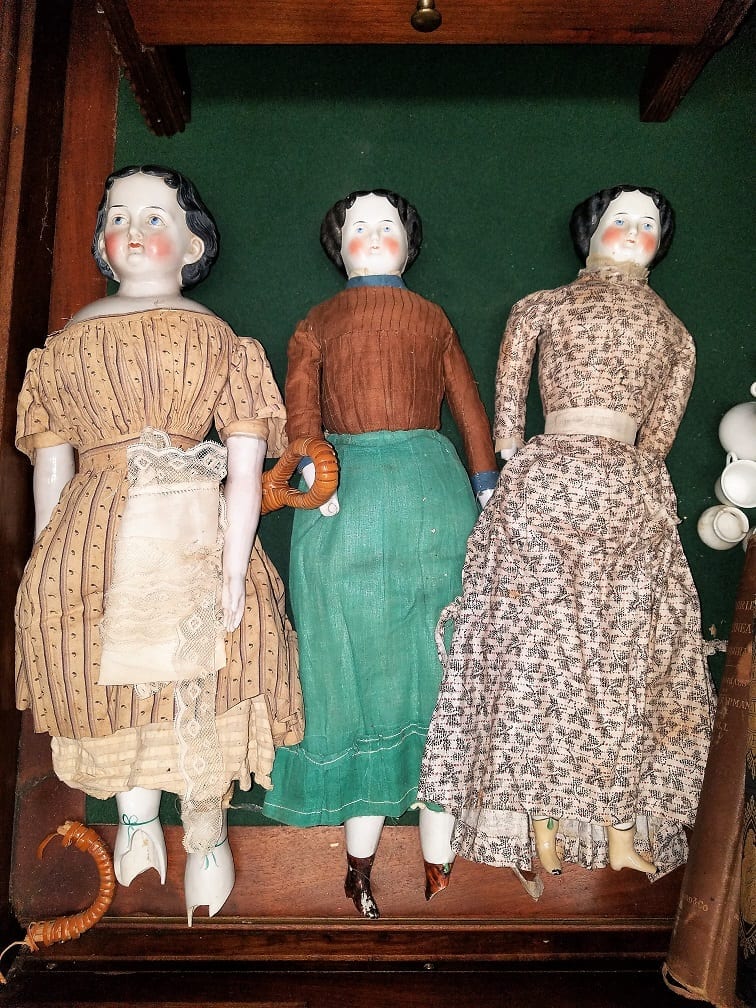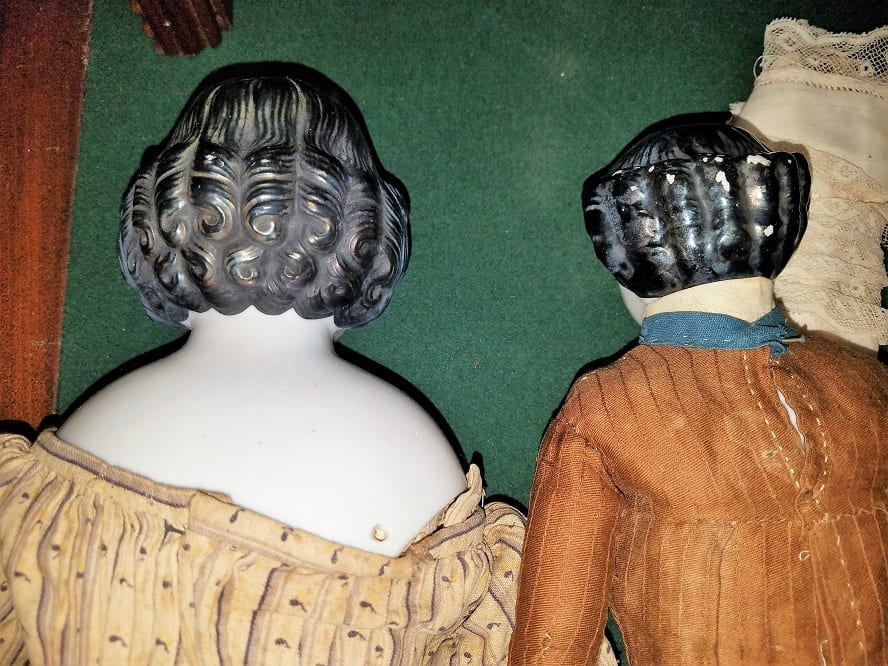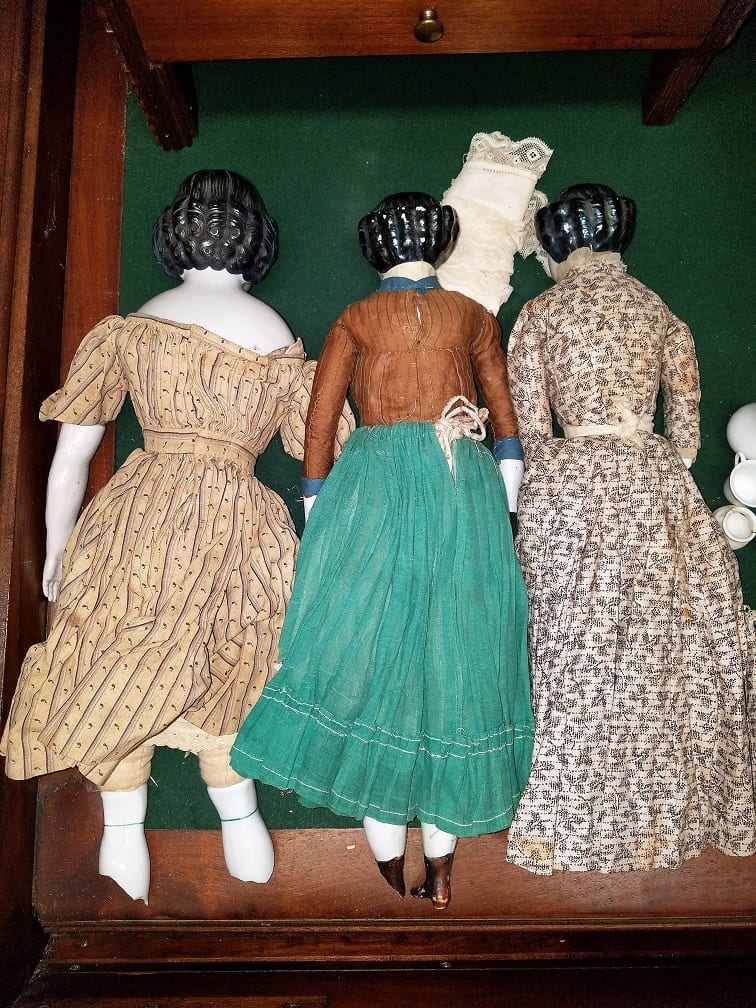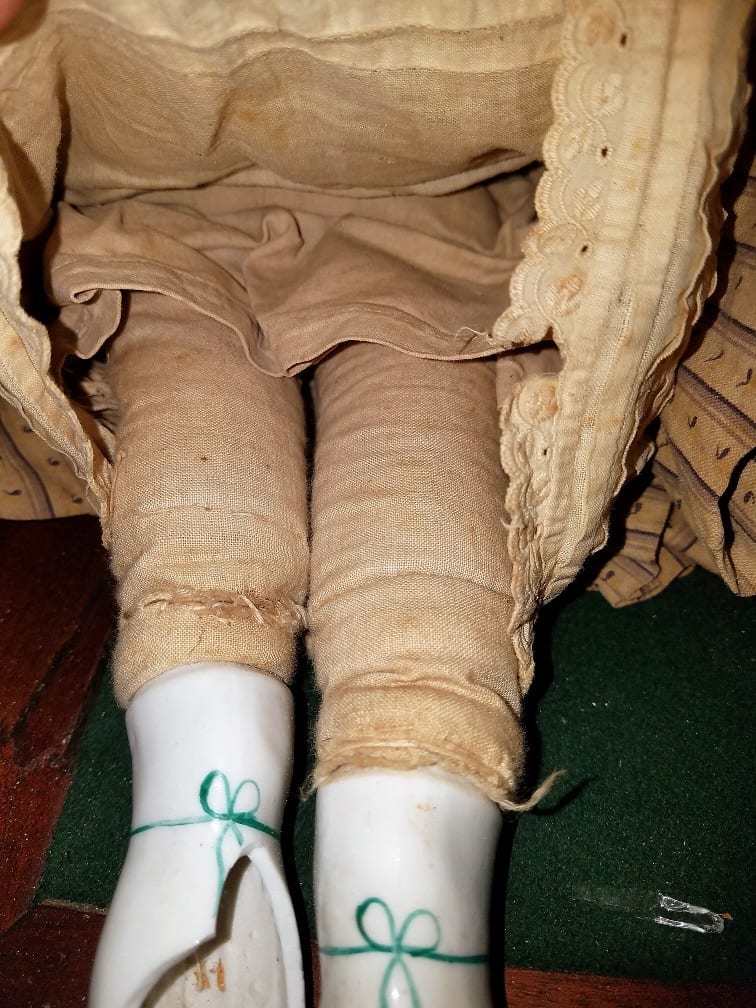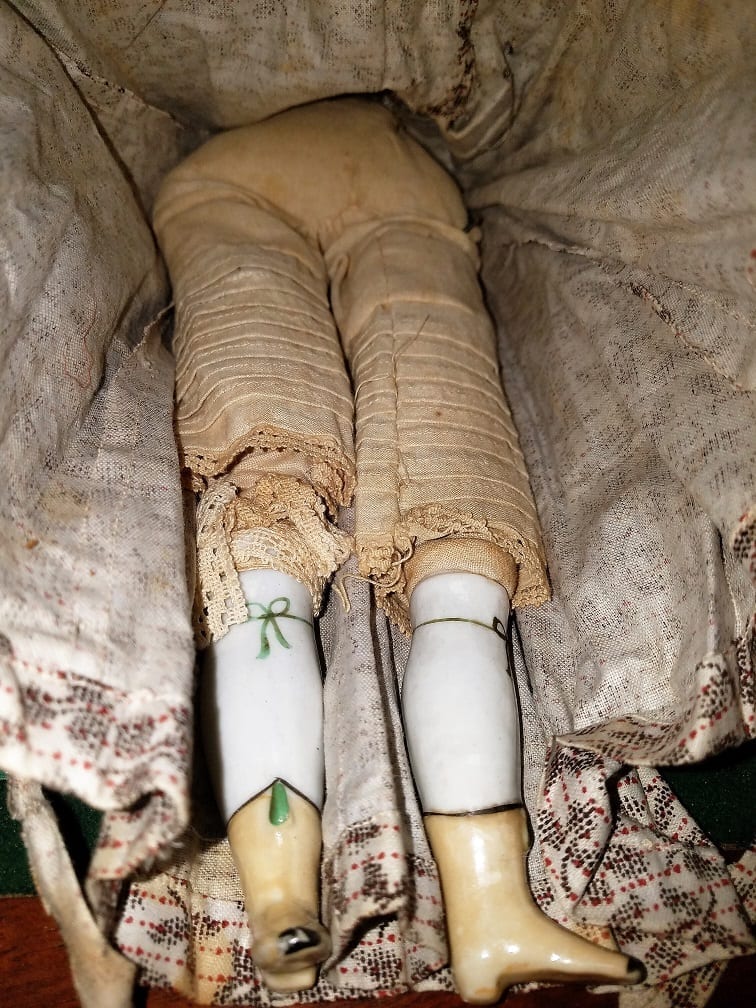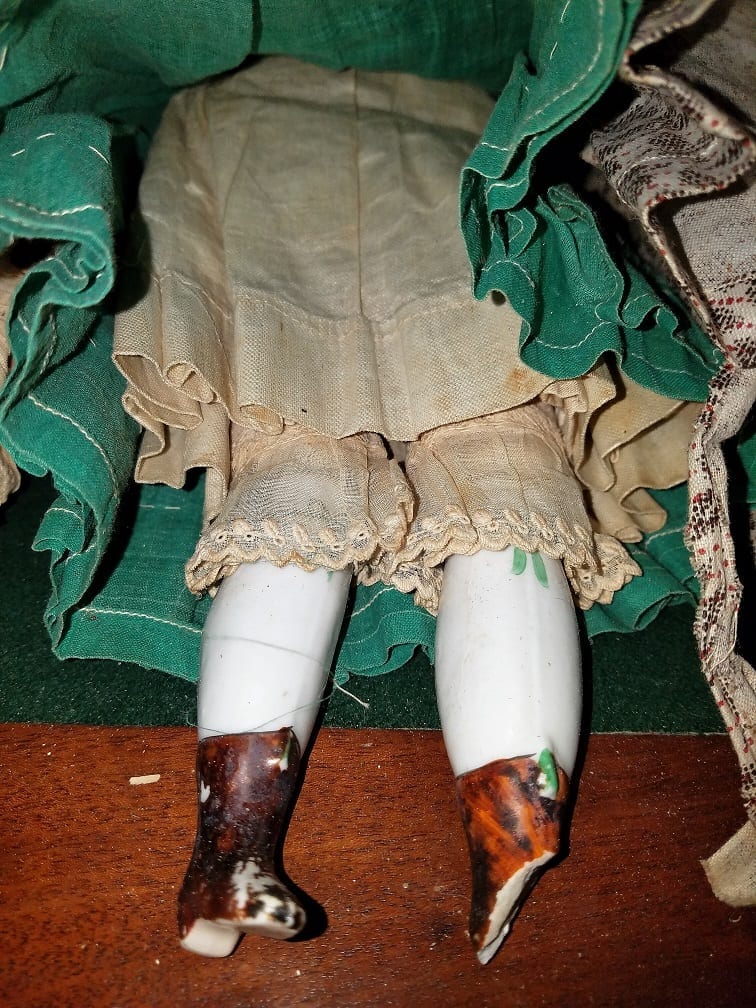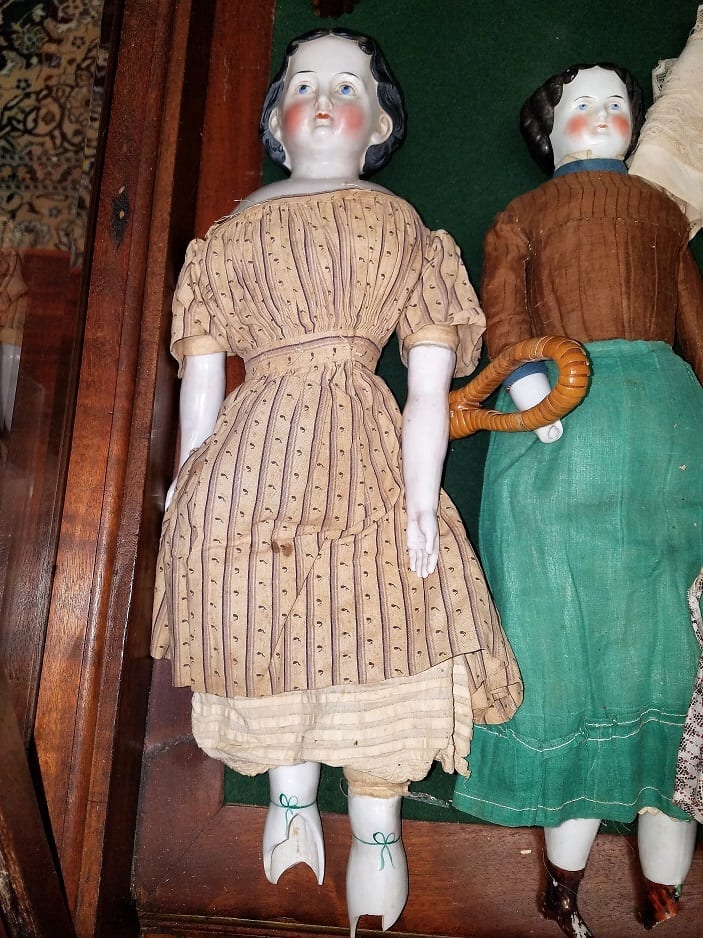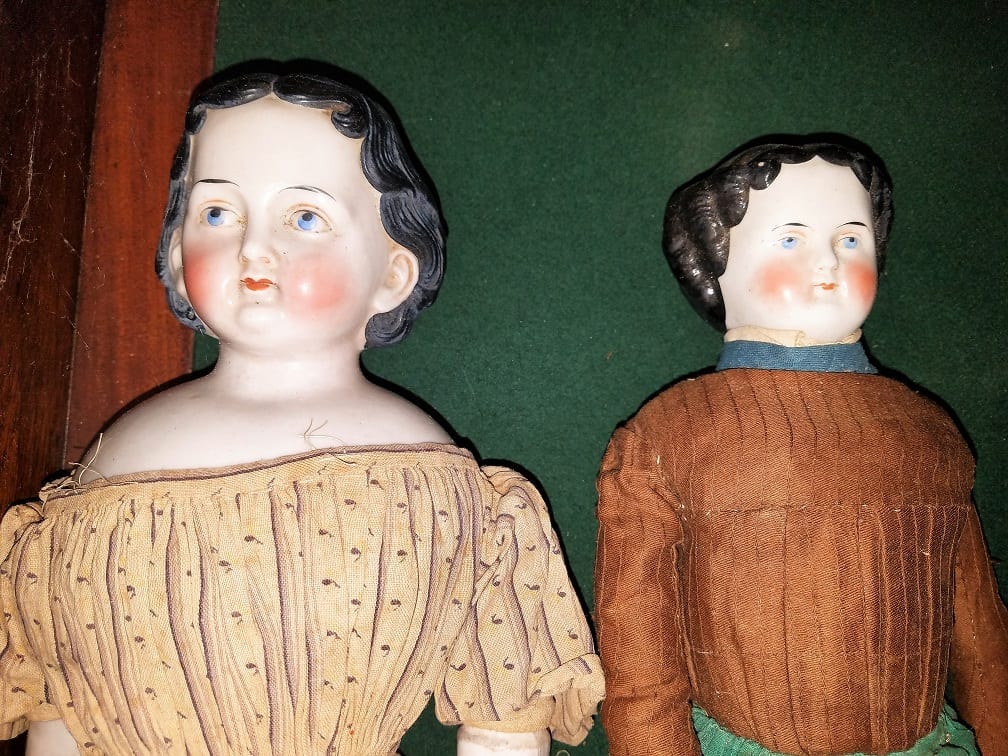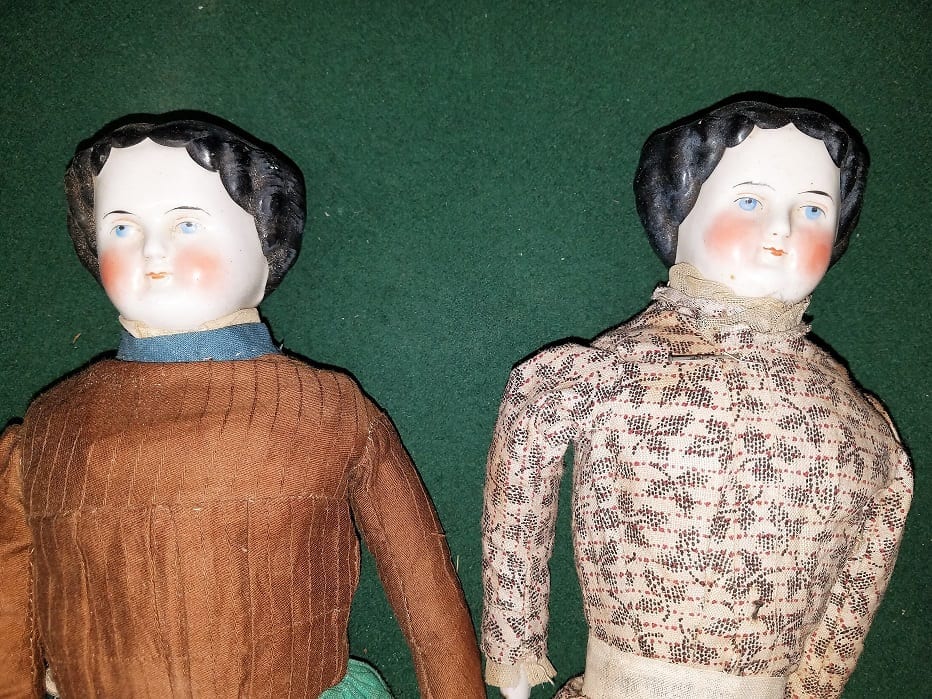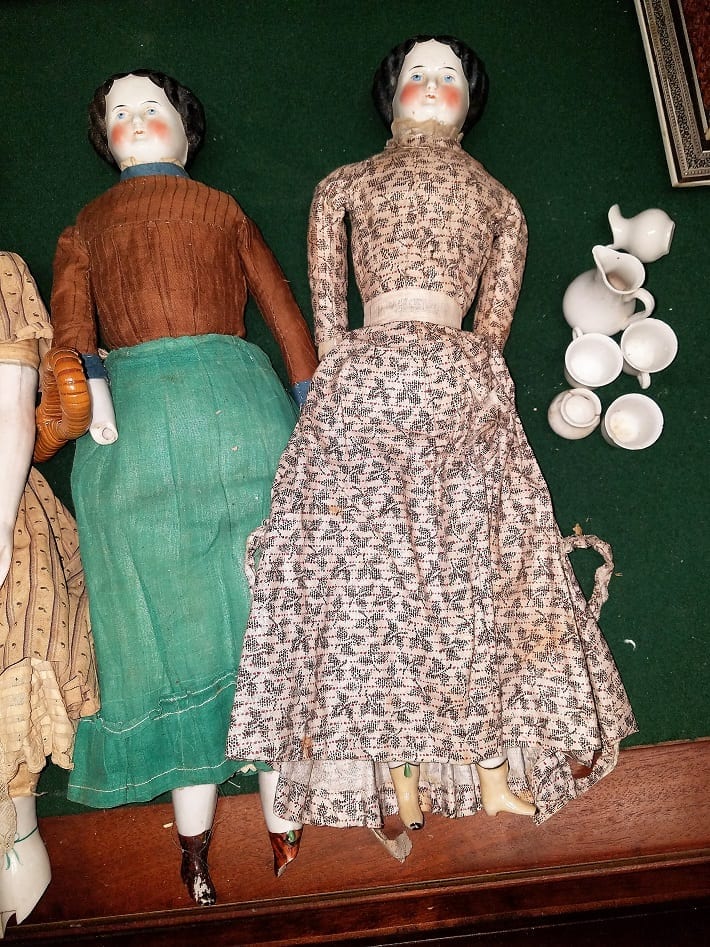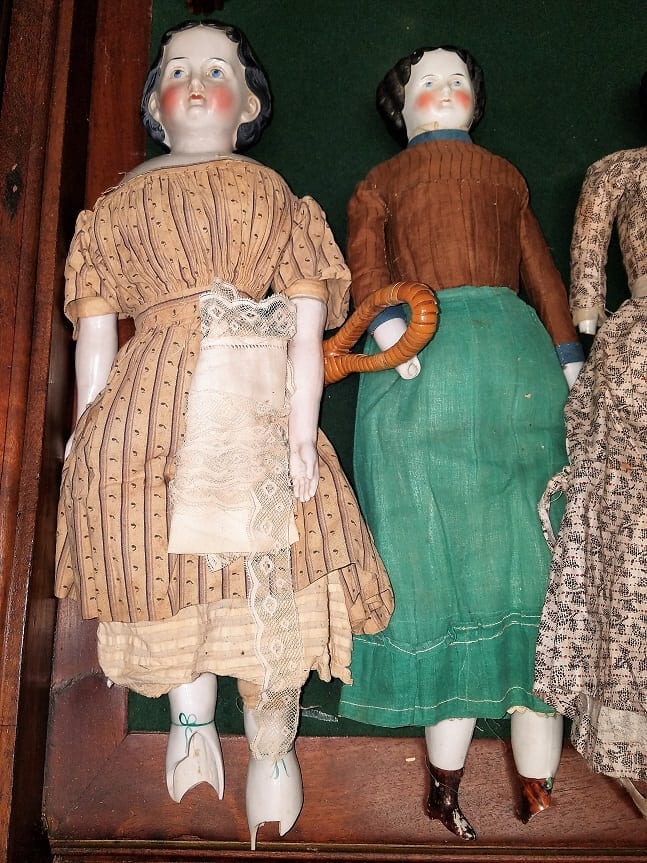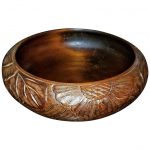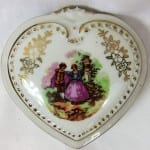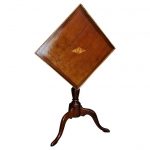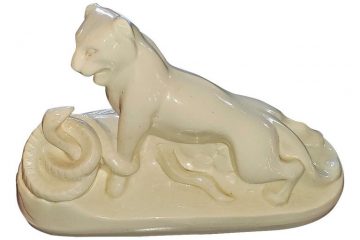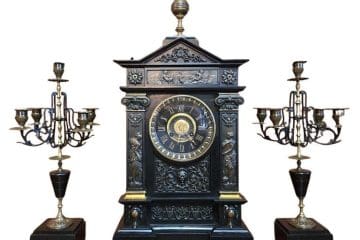19C American Civil War Era Porcelain Dolls – Provenance
PRESENTING an ABSOLUTELY STUNNING and HISTORIC 19C American Civil War Era Porcelain Dolls with Provenance – belonging to well known author, Lida Calvert Hall, circa 1860.
There are 3 Dolls:- one slightly larger than the other 2 and of much better quality and RARE and VALUABLE.
They are ALL in their ORIGINAL period calico clothing with lace undergarments.
The clothing is distinctively WESTERN in style and every piece of clothing would have been handmade in the US, around the time of the Civil War.
The Doll heads, arms and legs are all made of porcelain.
We are informed that one of them is an Adelina Patti (Center) and the other 2 are American.
Included in the Set are:- the 3 Dolls, Original Clothing & Some loose/extra clothing and 6 piece miniature porcelain tea set.
The porcelain is hand-painted for more detail.
The larger one in the center of the main picture is without doubt the best one….but the other 2 are also extremely good examples.
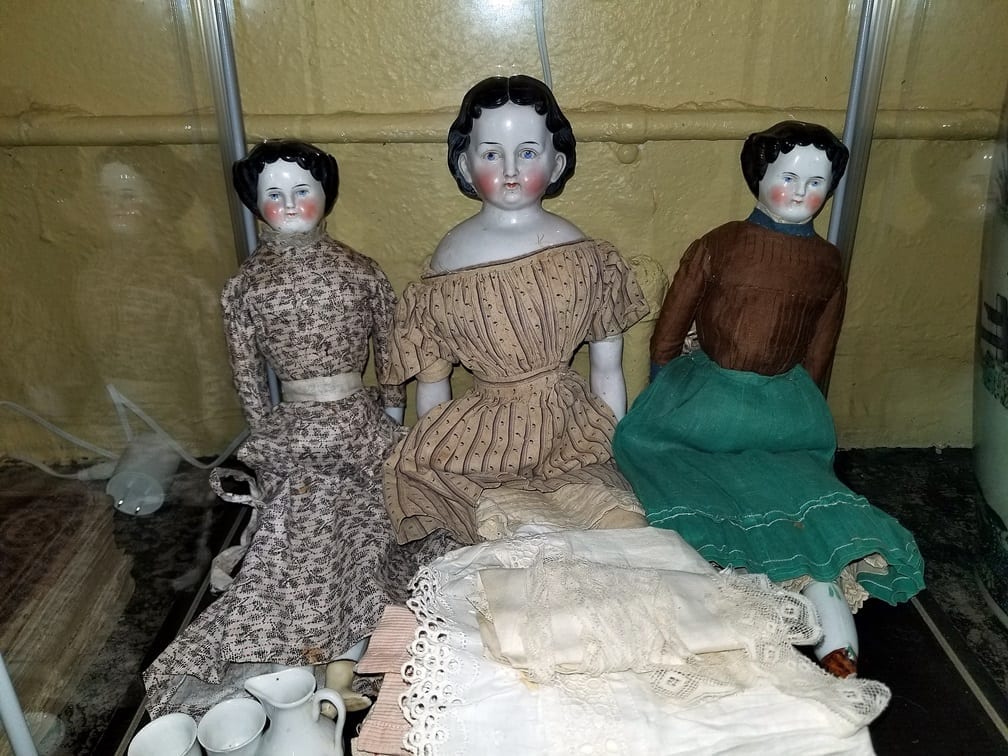
These were Lida Calvert Hall’s personal dolls and were discovered in a cedar chest belonging to her.
These would have been played with by Lida as a child growing up in Bowling Green, Kentucky.
Not only are they HISTORIC pieces in their own right…but….because Lida was a famous person they have added HISTORICAL SIGNIFICANCE and therefore are being sold together…not split up!
The mini porcelain tea set and additional original period clothing items, were also found with the dolls and are being included in the set being sold.
These Dolls have IMPECCABLE PROVENANCE:
They were part of the Lida Calvert Hall/Obenchain Collection and have been in the family’s possession since in or around 1860.
Eliza Caroline “Lida” Obenchain (née Calvert), (February 11, 1856 – December 20, 1935) was an American author, women’s rights advocate, and suffragist from Bowling Green, Kentucky. Lida Obenchain, writing under the pen name Eliza Calvert Hall, was widely known early in the twentieth century for her short stories featuring an elderly widowed woman, “Aunt Jane”, who plainly spoke her mind about the people she knew and her experiences in the rural south.
Lida Obenchain’s best known work is Aunt Jane of Kentucky which received extra notability when United States President Theodore Roosevelt recommended the book to the American people during a speech, saying, “I cordially recommend the first chapter of Aunt Jane of Kentucky as a tract in all families where the menfolk tend to selfish or thoughtless or overbearing disregard to the rights of their womenfolk.”
Eliza Caroline Calvert, daughter of Thomas Chalmers Calvert and Margaret (Younglove) Calvert, was born in Bowling Green, Kentucky on February 11, 1856. She was known as “Lida” throughout her life. Lida’s father Thomas Chalmers Calvert was born in Giles County, Tennessee to Samuel Wilson Calvert, a Presbyterian minister, and his wife Eliza Caroline (Hall) Calvert. Lida’s mother, Margaret Younglove, was from Johnstown, New York.
Lida attended a local private school, and then Western Female Seminary in Oxford, Ohio. She pursued two of the careers acceptable for a single woman in her era, teaching school and writing sentimental poetry. She began her professional writing career to help support her mother and siblings. Scribner’s Monthly magazine accepted two of her poems for publication in 1879 and paid her the equivalent of US$600. She continued writing and had at least six more poems published before age thirty.
On July 8, 1885, Lida married 44-year-old Major William Alexander Obenchain. Obenchain was a Virginia native and American Civil War veteran who in 1883 became president of Ogden College, a small men’s school in Bowling Green. Lida and William had four children: Margery, William Alexander Jr. (Alex), Thomas Hall and Cecilia (Cecil). Her family responsibilities left her with limited time to write. Her frustration as an unpaid housewife motivated her to support the cause of women’s suffrage and to work with the Kentucky Equal Rights Association.
In literary circles, Lida was known by her pseudo name, Eliza Calvert Hall. In addition to her commentaries on women’s suffrage written for Kentucky newspapers, she used many of her short stories to encode suffrage arguments. Those who read Aunt Jane of Kentucky, Lida’s first published collection of short stories in 1907, observed the simple mountain wisdom of Aunt Jane without being fully aware of the political subtext contained within the stories. President Theodore Roosevelt even publicly praised Lida for this collection of short stories that featured an elderly widowed woman, “Aunt Jane,” who told the experiences of the people in a rural southern town, named Goshen, to a younger woman visitor who relayed them to the reader. This type of rhetorical device, called a “double narrative,” was a common form of storytelling in this era.
William Obenchain died on August 17, 1916, after an extended illness. Family responsibilities caused her to move to Dallas, Texas to care for her daughter Margery, who had contracted tuberculosis. She continued to write, but her most productive years as a writer were past. After the death of her daughter in 1923, she stayed in Texas, where she died on December 20, 1935.
Link: https://en.wikipedia.org/wiki/Eliza_Calvert_Hall
Adelina Patti (19 February 1843 – 27 September 1919) was a Spanish opera singer. At the height of her career, she was earning huge fees performing in the music capitals of Europe and America. She first sang in public as a child in 1851, and gave her last performance before an audience in 1914. Along with her near contemporaries Jenny Lind and Thérèse Tietjens, Patti remains one of the most famous sopranos in history, owing to the purity and beauty of her lyrical voice and the unmatched quality of her bel canto technique.
The composer Giuseppe Verdi, writing in 1877, described her as being perhaps the finest singer who had ever lived and a “stupendous artist”. Verdi’s admiration for Patti’s talent was shared by numerous music critics and social commentators of her era.
Link: https://en.wikipedia.org/wiki/Adelina_Patti
A china doll is a doll made partially or wholly out of glazed porcelain. The name comes from china being used to refer to the material porcelain. Colloquially the term china doll is used to refer only glazed porcelain dolls.
A typical china doll has a glazed porcelain head with painted molded hair and a body made of cloth or leather. They range in size from more than 30″ (76 cm) tall to 1 inch (2.5 cm). Antique china dolls were predominantly produced in Germany, approximately between 1840 and 1940. Rare and elaborately decorated antique china dolls can have value on the collectors market. Beginning in the mid-20th-century reproductions of china dolls of various quality were produced in Japan and the United States.
Antique china dolls were predominantly produced in Germany, approximately between 1840 and 1940, with the peak in popularity between roughly 1840 and 1890. Unglazed bisque dolls became popular after 1850. Harper’s Bazaar referred to china dolls as “old fashioned” in 1873, though they continued being made well into the early 20th century. China doll heads were produced in large quantities, counting in the millions. Some of the most prolific manufacturers were companies like Kestner; Conta & Boehme; Alt, Beck and Gottschalck; and Hertwig. Other German companies include Kling, Kister, KPM, and Meissen. China dolls were also produced in Czechoslovakia (Schlaggenwald), Denmark (Royal Copenhagen), France (Barrois, Jacob Petit), Poland (Tielsch), and Sweden (Rörstrand),. The earliest known were made by Kestner, KPM, Meissen and Royal Copenhagen.
The earliest china dolls often depicted grown women. From approximately the 1850s on, child-like china dolls became popular. Blonde-haired china dolls became more prevalent at the end of the 1800s. These dolls display contemporary hairstyles: sausage curls, ribbons or headbands
Link: https://en.wikipedia.org/wiki/China_doll
THIS IS YOUR CHANCE TO OWN A PIECE OF AMERICAN HISTORY
PIECES OWNED AND PLAYED WITH,
BY A LEADING MEMBER OF THE SUFFRAGIST MOVEMENT AND FAMOUS AUTHOR
19C American Civil War Era Porcelain Dolls
Provenance: Part of the Lida Calvert Hall/Obenchain Collection, formerly of Bowling Green, Kentucky and Highland Park, Dallas, TX.
Condition: Overall in good ORIGINAL condition. These have been virtually UNTOUCHED by human hands in over 70 years.
The Heads and Torsos of all 3 Dolls are near mint. Some rubbing to the hair on the back.
There is damage to the feet of 2 of the Dolls. The large doll on the left has both feet broken and one hand broken. The doll second from the left has one foot and one hand broken. The doll on the right has one hand broken only.
The Doll tea set has historic repairs.
As Doll Collectors will tell you: damage to the feet and arms of these dolls is pretty much irrelevant to their value. The value in THESE dolls is in the heads, torsos, clothing and provenance.
The Set is being sold with original additional clothing items as can be seen in the display photo AND the doll porcelain tea set.
Dimensions: Large Doll (Center) 16.75″ Tall, 5.5″ Wide and 3″ Deep.
Medium Doll: (Right): 16″ Tall, 4″ Wide and 2.5″ Deep
Smallest Doll: (Left): 15.75″ Tall, 4″ Wide and 2.5″ Deep
A single doll (similar to the one on the left) have sold at Auction for circa $2,000 and that is WITHOUT the provenance, period clothing etc. that these dolls have!

